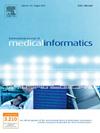评估数字耳镜在农村儿童中耳炎诊断中的疗效:全科医生和耳鼻喉专科医生的比较研究
IF 4.1
2区 医学
Q2 COMPUTER SCIENCE, INFORMATION SYSTEMS
International Journal of Medical Informatics
Pub Date : 2025-07-16
DOI:10.1016/j.ijmedinf.2025.106042
引用次数: 0
摘要
中耳炎是一种普遍的儿童疾病,特别是在特定人群中。然而,其诊断一直是一个严重问题,在获得耳鼻喉科专家的机会有限的贫困地区,这一问题更加严重。本研究旨在评估全科医生使用数字耳镜和标准耳镜诊断耳部疾病与耳鼻喉科医生诊断耳部疾病作为金标准的一致性。方法本研究调查了农村卫生中心的耳部检查,比较了数字耳镜和标准耳镜,全科医生(gp)的筛查和耳鼻喉科专家的远程数字耳镜评估。研究包括使用om级量表对三个诊断组的鼓膜进行分级:全科医生耳镜、耳鼻喉科视频耳镜和全科医生视频耳镜。使用Cohen 's kappa系数评估诊断一致性,家长/监护人和医生都对检查方法提供了反馈,探索远程医疗在远程医疗评估中的潜力。结果共纳入4个农村卫生院的82名儿童,其中男孩45名,女孩37名。耳鼻喉科专科医生和全科医生对视像耳镜检查患者耳朵的诊断有显著的一致性(0.90%)。医师调查结果显示,医师完全同意(100%)。该系统易于使用,视频耳镜可用于远程医疗和更好的患者互动。值得注意的是,本研究结果显示,暴露后儿童的家长满意度很高(98%)。结论数字视频耳镜可以提高全科医生对耳科疾病的诊断准确性,特别是在耳鼻喉科医生就诊机会有限的地区。通过促进改进的可视化、远程咨询和更有效的转诊,该技术有望增强初级保健提供者的能力,并扩大优质耳科医疗保健的范围。将视频耳镜集成到远程医疗平台可以进一步支持服务不足地区的全科医生,在优化医疗资源的同时改善患者的治疗效果。本文章由计算机程序翻译,如有差异,请以英文原文为准。
Evaluating the efficacy of digital otoscopes in rural pediatric otitis media diagnosis: A comparative study of general practitioners and ENT specialists
Background
Otitis media is a prevalent childhood illness, particularly among specific groups. However, its diagnosis has been of a serious issue, which is exacerbated in underprivileged regions with limited access to Ear, nose and throat specialists. This study aimed to evaluate the agreement between diagnoses of ear diseases made by general practitioners using digital otoscope and standard otoscope, and the diagnoses determined by an otolaryngologist, as the gold standard.
Methods
This study examined ear examinations in rural health centers, comparing digital otoscope and standard otoscope, screenings by general practitioners (GPs) with remote digital otoscope evaluations by an ENT specialist. The research involved grading tympanic membranes using the OM-grade scale across three diagnostic groups: GP otoscope, ENT video otoscope, and GP video otoscope. Diagnostic agreement was assessed using Cohen’s kappa coefficient, and both parents/guardians and physicians provided feedback on the examination methods, exploring the potential of telemedicine in remote medical assessments.
Results
A total of 82 children, 45 boys and 37 girls, were included in the study from 4 rural health centers. There was a significant agreement (0.90%) between the diagnoses of the ENT specialist and the general practitioner with the video-otoscope examining the patients’ ears. The results of the physician survey showed that the physicians were in complete agreement (100%). The system is easy to use and the video-otoscope can be useful for telemedicine and greater patient interaction. It is worth noting that the results of this study showed a high level of satisfaction (98%) among the parents of the children after exposure.
Conclusion
Our findings provide strong evidence that digital video otoscope can enhance the diagnostic accuracy of GPs in detecting ear diseases, especially in settings with limited access to ENT specialists. By facilitating improved visualization, remote consultation, and more efficient referrals, this technology holds promise for empowering primary care providers and expanding the reach of quality ear healthcare. Integration of video otoscope into telemedicine platforms could further support GPs in underserved areas, improving patient outcomes while optimizing healthcare resources.
求助全文
通过发布文献求助,成功后即可免费获取论文全文。
去求助
来源期刊

International Journal of Medical Informatics
医学-计算机:信息系统
CiteScore
8.90
自引率
4.10%
发文量
217
审稿时长
42 days
期刊介绍:
International Journal of Medical Informatics provides an international medium for dissemination of original results and interpretative reviews concerning the field of medical informatics. The Journal emphasizes the evaluation of systems in healthcare settings.
The scope of journal covers:
Information systems, including national or international registration systems, hospital information systems, departmental and/or physician''s office systems, document handling systems, electronic medical record systems, standardization, systems integration etc.;
Computer-aided medical decision support systems using heuristic, algorithmic and/or statistical methods as exemplified in decision theory, protocol development, artificial intelligence, etc.
Educational computer based programs pertaining to medical informatics or medicine in general;
Organizational, economic, social, clinical impact, ethical and cost-benefit aspects of IT applications in health care.
 求助内容:
求助内容: 应助结果提醒方式:
应助结果提醒方式:


